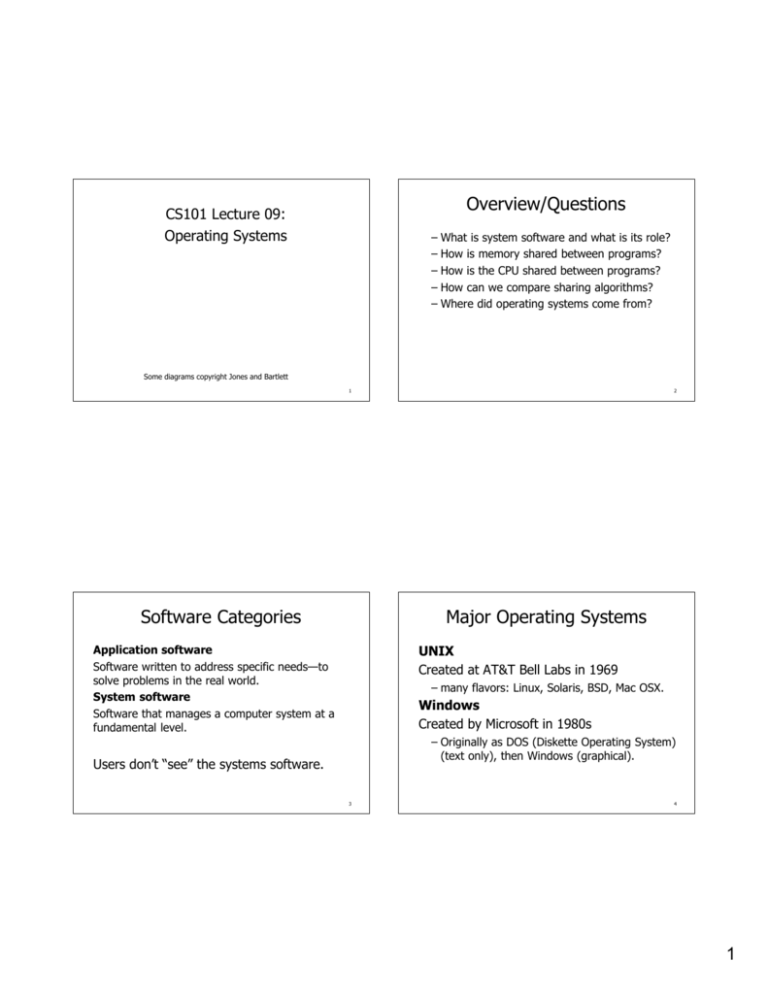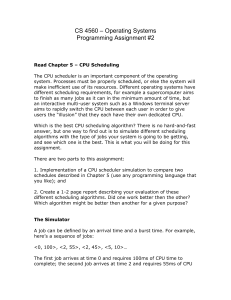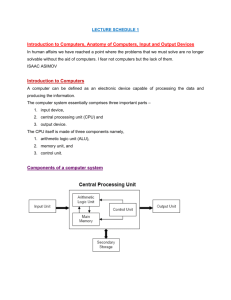Overview/Questions Software Categories Major Operating Systems
advertisement

Overview/Questions CS101 Lecture 09: Operating Systems ± What is system software and what is its role? ± How is memory shared between programs? ± How is the CPU shared between programs? ± How can we compare sharing algorithms? ± Where did operating systems come from? Some diagrams copyright Jones and Bartlett 1 Software Categories 2 Major Operating Systems UNIX Created at AT&T Bell Labs in 1969 Application software Software written to address specific needs² needs²to solve problems in the real world. System software Software that manages a computer system at a fundamental level. ± many flavors: Linux, Solaris, BSD, Mac OSX. Windows Created by Microsoft in 1980s ± Originally as DOS (Diskette Operating System) (text only), then Windows (graphical). Users don¶t ³see´ the systems software. 3 4 1 Roles of an Operating System Roles of an Operating System An operating system is system software which provides: ± instructions for booting up the computer when it is powered on. ± the file system in which data can be stored in secondary storage. ± management of computing hardware ± procedure and interface to launch all other programs. Figure 10.1 An operating system interacts with many aspects of a computer system. 5 Resource Management 6 Resource Management Multiprogramming Memory Management The process of keeping track of what programs are in memory and where in memory they reside. The technique of keeping multiple programs in main memory at the same time so that they can compete for access to the CPU. Process Management A process or job is a program in execution. How to share one set of hardware between many programs? CPU Scheduling Determining which process in memory is executed by the CPU at any given point. Most of the roles of an operating system generally revolve around the idea of ³sharing ³sharing nicely.´ nicely.´ 7 8 2 Batch Processing Timesharing System The first operating system was a human operator, operator, who organized various jobs from multiple users into batches of jobs that needed the same resources. A timesharing system allowed multiple users to interact with a computer at the same time. All terminals connected to one mainframe or minicomputer, which had processor and memory. Virtual Machine The illusion created by a timesharing system that each user has his/her own machine. 9 Memory Management 10 Memory Management Operating systems must employ techniques to Program 1: variable min is assigned to memory location 23, a location relative to Program 1 ± Track where and how a program resides in memory ± Convert logical addresses into physical addresses Logical address Location of a variable (stored value) relative to the program making the reference to it. Physical address Actual address in the main memory (RAM) circuits. 11 OS must bind min (relative location 23) to a specific physical memory address Logical address for min (23) is bound to physical address in memory (e.g. 20350) before the program runs Figure 10.3 Memory is a continuous set of bits referenced by specific addresses 12 3 Paged Memory Management Memory Management Techniques Binding the process of mapping a logical memory address to a physical memory address. Demand Paging An extension of paged memory management. ± unused pages are stored in secondary memory ± pages brought into main memory on demand Paged memory management is a technique for efficiently binding and sharing memory. Virtual Memory The illusion that there are no restrictions on the size of a program¶s memory because the entire process need not be in memory at one time. ± Process memory space is divided into pages ± Pages get loaded to physical memory frames ± Many frames loaded at the same time, even from different processes. ± programs not limited by physical memory size 13 Paged Memory Management 14 Process Management A page swap is the act of bringing a page from secondary memory (e.g. disk) into main memory Process Management The act of managing the use of the CPU by individual processes. Recall that a process is a program in execution. ± often causes another page to be written back to secondary memory. Thrashing Inefficient processing caused by constant page swaps. Process States Processes go through several states (waiting, ready, running«) as they execute. 15 16 4 Process Management Process Management There is only one CPU and therefore only one set of CPU registers, which contain the values for the currently executing process. Process Control Block (PCB) A data structure used by the OS to manage information about a process, including ± current value of the program counter ± values of all CPU registers for the process Figure 10.8 The process life cycle 17 Process Management 18 Process Management Processes are tracked by state, with a list of PCBs, one for each process in that state. Each OS has a way to see which processes are running, how much CPU/memory they¶re using, and to kill an errant process: A context switch occurs when a process is moved to different state: ± Register values for the currently running process are stored into its PCB. ± Its PCB is moved to the list of the state into which it goes. ± Register values of the new process moving into the running state are loaded into the CPU. 19 20 5 CPU Scheduling CPU Scheduling CPU Scheduling The act of determining which process in the ready state should be moved to the running state. NonNon-preemptive Scheduling The currently executing process gives up the CPU voluntarily. Preemptive Scheduling The operating system decides to favor another process, preempting the currently executing process. Turnaround Time The amount of time between when a process arrives in the ready state the first time and when it exits the running state for the last time. ± Many processes may be in the ready state at the same time. ± Only one process can be in the running state, making progress at any one time. Which one gets to move from ready to running? 21 CPU Scheduling Algorithms 22 FirstFirst-Come, FirstFirst-Served FirstFirst-Come, FirstFirst-Served Processes are moved to the CPU in the order in which they arrive in the running state. Shortest Job Next Process with shortest estimated running time in the ready state is moved into the running state first. Round Robin Each process runs for a specified time slice and moves from the running state to the ready state to await its next turn if not finished. 23 Consider this set of processes, and their respective run times. Here¶s the order: What is the average turnaround time? 24 6 First Come, First Served Shortest Job Next Completion times are as follows: p1 140 p2 215 p3 535 p4 815 p5 940 Consider this set of processes, and their respective run times. Here¶s the order: Average turnaround time is: (140+215+535+815+940)/5 = 529 25 Shortest Job Next What is the average turnaround time? 26 Round Robin Every process is treated the same! Completion times are as follows: p2 75 p5 200 p1 340 p4 620 p3 940 Time Slice (a.k.a. quantum) The amount of CPU time each process receives before being preempted. When preempted, a process: ± exits the CPU ± returns to the ready state ± allows another process its turn Average turnaround time is: (75+200+340+620+940)/5 = 495 27 28 7 Round Robin Round Robin Completion times are as follows: p1 515 p2 315 p3 940 p4 920 p5 640 Consider this set of processes, and their respective run times. Quantum of 50: Average turnaround time is: (515+325+940+920+640)/5 = 668 What is the average turnaround time? 29 CPU Scheduling Algorithms Brief History of Operating Systems Multics: Multics: Developed at MIT, AT&T, GE in 1960s to run on a mainframe computer. Average TurnTurn-Around Times FCFS: SJN: RR: 529 495 668 30 ± MultiMulti-user, time sharing ± Memory mapping, multimulti-processor, etc. (best) (worst) Are these algorithms fair? Why or why not? What are the shortcomings of each? What enhancements might you suggest? UNIX: Developed at AT&T in 1970s ± MultiMulti-user ± CommandCommand-line interpreter (CLI) ± Became popular in academia 31 32 8 Brief History of Operating Systems DOS (Diskette (Diskette Operating System): System): CommandCommand-line Interpreter Programs are launched and input/output done via texttext-based interface. ± Developed for the IBM Personal Computer ± A company called Microsoft got the contract to develop. ± ³one computer, one user, one program´ paradigm. ± CommandCommand-line interpreter 33 User Interfaces User Interfaces Windows, Icons, Menus, and Pointing device Developed at Xerox PARC in 1970s: ± ± ± ± ± 34 Steve Jobs and team from Apple visited PARC, and soon thereafter« bitmapped graphics display movable/resizable windows buttons and poppop-up menus computer ³desktop´ 3 button mouse. The Apple Lisa was released in 1983. 35 36 9 User Interfaces User Interfaces «and the Macintosh in 1984 Microsoft began developing Windows in 1985« A small company called Microsoft got the contract to develop productivity applications to be bundled with the Macintosh. but its popularity didn¶t really begin until 1990 with the introduction of Windows 3.1. 37 Summary 38 Student To Dos ± The system software manages/shares systems resources (memory, CPU time, input/output devices) among programs. ± Memory management enables multiple programs to share limited physical memory. ± CPU scheduling enables multiple processes to share the CPU¶s time fairly (if not efficiently). 39 ± Readings: CSI 10.1, 10.3, 10.4 ± HW2 due Thursday 6/5 ± Extra lab on June 18, 11am11am-noon 40 10







